Class 8 History Chapter 5 Notes - When People Rebel
| Table of contents |

|
| Introduction |

|
| Policies and the People |

|
| Through the Eyes of the People |

|
| A Mutiny Becomes a Popular Uprising |

|
| The Company Fights Back |

|
| Aftermath |

|
| Important Dates |

|
Introduction
The Revolt of 1857, also known as the First War of Independence, was a pivotal event in Indian history, marking the first large-scale uprising against British rule. This chapter examines the causes, key events, and aftermath of the revolt, highlighting its significance in shaping the future of India's struggle for independence.
Significance of 1857: First large-scale resistance to British rule in India.
- Causes of the Revolt: Political discontent, economic exploitation, and cultural insensitivity by the British.
- Key Events: The revolt began in Meerut and spread across India, with significant battles in Delhi, Kanpur, and Jhansi.
- Aftermath and Consequences: The revolt was suppressed, leading to direct British Crown rule in India and changes in governance.
- Legacy: The revolt is seen as the beginning of India's struggle for independence and influenced future nationalist movements.

Policies and the People
The policies of the East India Company affected different people, like kings, queens, peasants, landlords, tribals, and soldiers, in different ways.
 The Revolt of 1857
The Revolt of 1857
Nawabs Lose their Power
- From the middle of the 18th century, the Nawabs and Rajas had seen their power eroded. They progressively lost their authority and honor.
- The inhabitants had been stationed in numerous courts, the freedom of the rulers had been reduced, their armed forces dismantled, and their revenues and territories removed in stages.
- Numerous family leaders have attempted to negotiate with the Company to protect their interests. For example, Rani Lakshmibai of Jhansi wanted society to recognize her adoptive son as heir to the kingdom after her husband's death.
- Nana Saheb, the adopted son of Peshwa Baji Rao II, pleaded that he be given his father’s pension when the latter died.
- Awadh was one of the last territories to be annexed by the Company. In 1801, a subsidiary alliance was forced upon Awadh, and in 1856, the Company took control of it.
- Governor-General Dalhousie claimed that Awadh was being poorly governed and that British rule was necessary for proper administration.
- The Company even made plans to end the Mughal dynasty. They removed the name of the Mughal king from the coins they minted and declared that after the death of Bahadur Shah Zafar, the king's family would be relocated from the Red Fort and given another place to reside in Delhi.
- In 1856, Governor-General Canning decided that Bahadur Shah Zafar would be the last Mughal king, and none of his descendants would be recognized as kings, only as princes.
The Peasants and the Sepoys
- Peasants and zamindars from the countryside resented the high taxes and the rigid methods of revenue collection.
- Many lost their lands as they failed to pay back their loans to the moneylenders.
- The Indian sepoys who were employees of the Company were unhappy about their pay, allowances and conditions of service.
- Many people in the country believed that if they crossed the sea they would lose their religion and caste.
- When sepoys were told to go to Burma to fight for the Company via sea route, they refused to go but agreed to go via land route.
- They were harshly punished, and since the problem didn't go away, in 1856 the Company made a new rule. This rule said that anyone who joined the Company's army had to agree to serve abroad if needed.
- Sepoys also reacted to what was happening in the countryside as many of them were peasants and had families living in villages.
- So the anger of the peasants quickly spread among the sepoys.
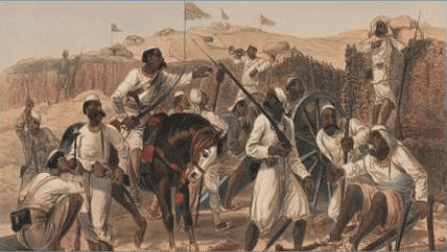
Responses to Reforms
- The British reformed Indian society by passing laws to stop the practice of Sati and to encourage the remarriage of widows.
- English education was widely promoted.
- Many Indians began to feel that the British were destroying their religion, their social customs and their traditional way of life.
- After 1830, Christian missionaries were allowed to function freely in its domain and own land and property.
- A new law was passed in 1850, to convert to Christianity easier.
- The law allowed Indian Christians to inherit the property of their ancestors.
Through the Eyes of the People
- Understanding the Sentiment Against British Rule: The sentiments and thoughts of people during British rule were captured in various sources, providing insights into the unrest and resistance among Indians.
- Source 1: The List of Eighty-Four Rules
Vishnubhatt Godse's Experience: On his journey, Vishnubhatt Godse met sepoys who warned of an impending upheaval. The British allegedly created eighty-four rules to eliminate Hindu and Muslim religions. Indian kings strongly opposed these rules, leading to secret war preparations. - Source 2: Memoirs of Subedar Sitaram Pande
Distrust Among Sepoys: The British annexation of Oudh caused deep mistrust among sepoys. Agents spread rumors urging sepoys to rebel and restore the Emperor of Delhi. - Controversial Rifle Cartridges: New rifle cartridges were rumored to be greased with cow and pig fat, angering sepoys. This incident intensified the belief that the British aimed to convert Indians to Christianity.
A Mutiny Becomes a Popular Uprising
- A large number of people believed that they had a common enemy and rose up against the enemy at the same time.
- For such a situation to develop people have to organize, communicate, take initiative, and display the confidence to turn the situation around.
- In May 1857, the English East India Company faced a massive rebellion.
- In several places, sepoys mutinied beginning from Meerut and a large number of people from different sections of society rose up in rebellion.
- It is considered as the biggest armed resistance to colonialism in the nineteenth century.

From Meerut to Delhi
- On 8 April 1857, Mangal Pandey, a young soldier, was hanged for attacking his officers in Barrackpore.
- Some days later, sepoys in Meerut refused to use the new cartridges suspected of being coated with the fat of cows and pigs.
- 85 sepoys were dismissed and sentenced to ten years in jail for disobeying their officers on 9 May 1857. The response of other Indian soldiers in Meerut was extraordinary.
- On 10 May, the soldiers marched to the jail in Meerut and released the imprisoned sepoys.
- They attacked and killed British officers, captured guns and ammunition, and set fire to British buildings and properties.
- The soldiers declared war on the British and aimed to end their rule in the country.
- The soldiers chose the Mughal emperor Bahadur Shah Zafar as their leader.
- They rode all night to reach Delhi and spread the rebellion to regiments stationed there.
- British officers were killed, arms and ammunition seized, and buildings set on fire.
- The soldiers gathered around the Red Fort and demanded to meet Bahadur Shah Zafar.
- The emperor reluctantly accepted their demand and became their leader.
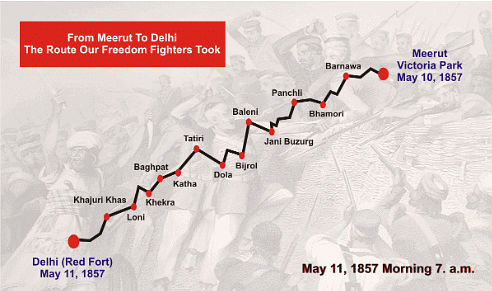
- Bahadur Shah Zafar wrote letters to chiefs and rulers of the country to form a confederacy against the British.
- Many smaller rulers and chieftains saw this as an opportunity to regain their territories under Mughal authority.
- The British did not anticipate this rebellion and thought the issue of cartridges would die down.
- Bahadur Shah Zafar's decision to support the rebellion changed the situation dramatically.
- People were inspired and motivated by the alternative possibility of Mughal rule, giving them courage and hope to act.
The Uprising Spreads
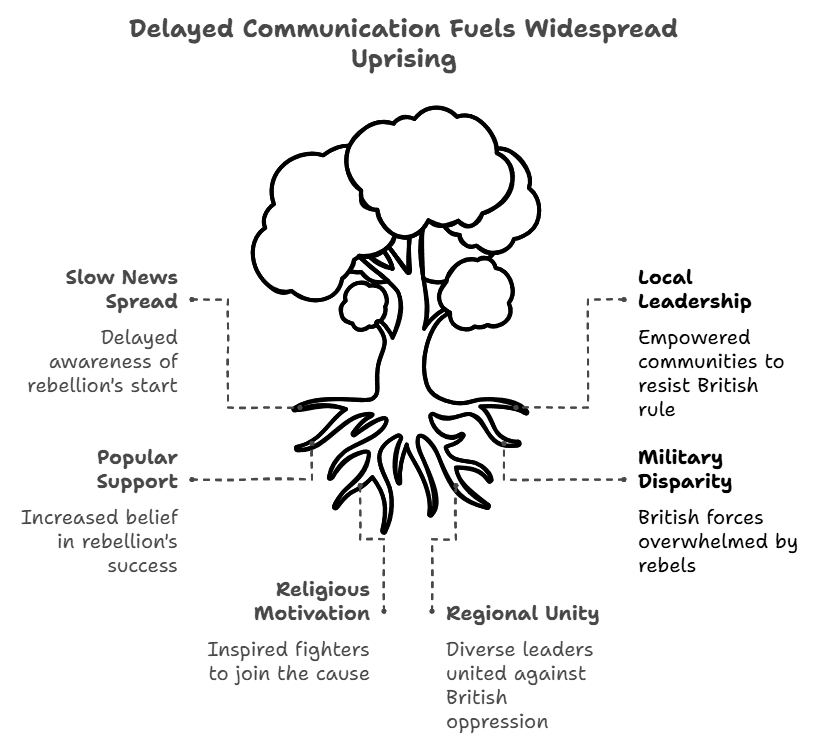
- After the British were driven out of Delhi, there was a delay of almost a week before news of the uprising spread. Following the initial news, a wave of mutinies started, with regiment after regiment joining other rebel troops in important locations like Delhi, Kanpur, and Lucknow.
- The towns and villages also rose up in rebellion, rallying around local leaders, zamindars, and chiefs who were willing to establish their authority and fight against the British.
- Nana Saheb, the adopted son of the late Peshwa Baji Rao, expelled the British garrison from Kanpur and declared himself the Peshwa, under the suzerainty of Emperor Bahadur Shah Zafar.
- In Lucknow, Birjis Qadr, the son of the deposed Nawab Wajid Ali Shah, was proclaimed the new Nawab, also recognizing the suzerainty of Bahadur Shah Zafar. Begum Hazrat Mahal, his mother, played an active role in organizing the uprising.
- Rani Lakshmibai of Jhansi joined the rebel sepoys and fought against the British alongside Tantia Tope, the general of Nana Saheb.
- Rani Avantibai Lodhi of Ramgarh led an army against the British in the Mandla region of Madhya Pradesh.
- The British were heavily outnumbered by the rebel forces and suffered defeats in several battles, which led to widespread belief among the people that British rule had collapsed.
- Ahmadullah Shah, a maulvi from Faizabad, gained popularity by prophesying the end of British rule and raising a large force of supporters.
- Ghazis, or religious warriors, gathered in Delhi to eliminate the British. Bakht Khan, a soldier from Bareilly, became a key military leader of the rebellion.
- Zamindar Kunwar Singh from Bihar joined the rebel sepoys and fought against the British for many months.
- Leaders and fighters from various regions of India joined the uprising, demonstrating the widespread nature of the rebellion.
The Company Fights Back
- The Company responded to the revolt with force, bringing reinforcements from England and passing new laws to easily convict the rebels.
- Delhi was recaptured in September 1857, and the last Mughal emperor, Bahadur Shah Zafar, was tried and sentenced to life imprisonment.
- Bahadur Shah Zafar and his wife were sent to prison in Rangoon in October 1858, and he died there in November 1862.
- The rebellion did not die down after the recapture of Delhi, and people continued to resist the British.
- The British had to fight for two years to suppress the massive forces of popular uprising.
- Lucknow was taken in March 1858, and Rani Lakshmibai and Rani Avantibai were defeated and killed in June 1858.
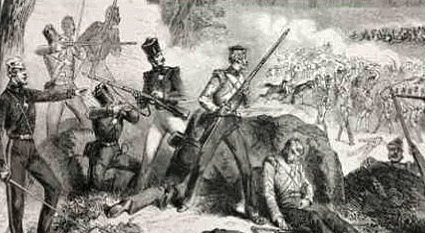 Company Fights Back
Company Fights Back
- Tantia Tope escaped to the jungles of central India and continued to fight a guerrilla war with the support of tribal and peasant leaders. He was captured, tried, and killed in April 1859.
- The defeat of rebel forces led to desertions, weakening the rebellion.
- The British aimed to regain loyalty by offering rewards to loyal landholders, allowing them to keep their traditional rights.
- Rebels who surrendered and had not killed any British people were promised safety and the retention of their land rights.
- Despite these offers, many sepoys, rebels, nawabs, and rajas were tried and hanged.
Aftermath
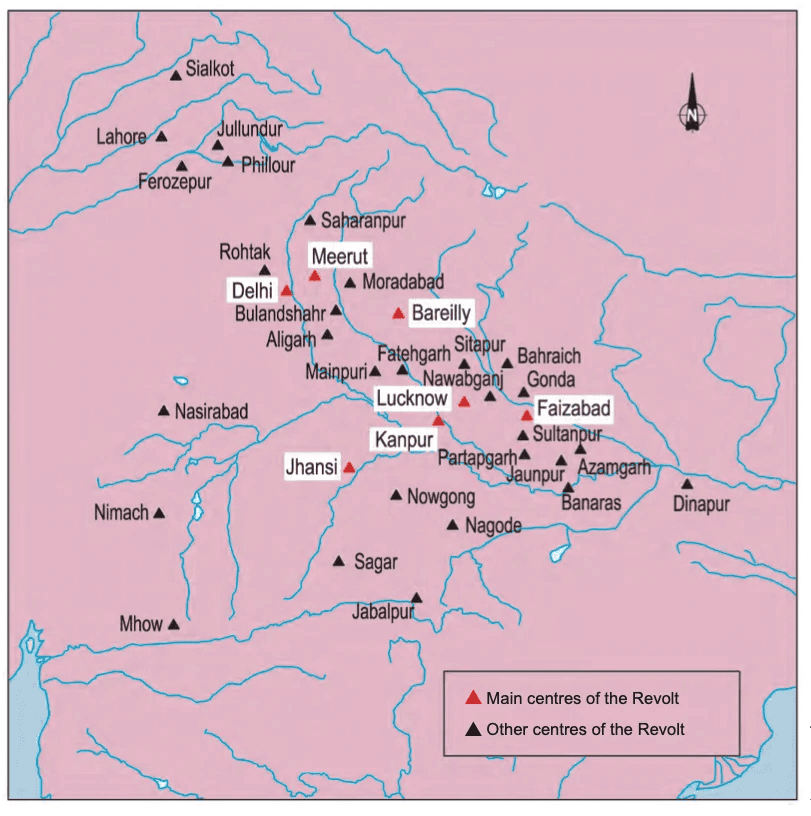 Some Important Centres of the Revolt in North IndiaIn 1859, the British regained control of India but realized that they needed to change their policies.
Some Important Centres of the Revolt in North IndiaIn 1859, the British regained control of India but realized that they needed to change their policies.
- The British Parliament passed a new law in 1858, transferring the powers of the East India Company to the British Crown. This ensured a more responsible management of Indian affairs. A member of the British Cabinet was appointed Secretary of State for India and given a council called the India Council to advise him. The Governor-General of India was given the title of Viceroy, representing the Crown. The British government accepted direct responsibility for ruling India through these measures.
- The ruling chiefs of India were assured that their territories would not be annexed in the future. They could pass on their kingdoms to their heirs, including adopted sons, but they had to acknowledge the British queen as their Sovereign Paramount.
- The proportion of Indian soldiers in the army was reduced, and more European soldiers were recruited. Soldiers were recruited from the Gurkhas, Sikhs, and Pathans instead of Awadh, Bihar, central India, and south India.
- Muslims faced suspicion and hostility, with their land and property being confiscated on a large scale. The British believed they were responsible for the rebellion.
- The British decided to respect the religious and social practices of the Indian people.
- Policies were implemented to protect landlords and zamindars, ensuring their rights over their lands.
These changes marked the beginning of a new phase in Indian history after 1857.

Important Dates
- 1801: A subsidiary Alliance was imposed on Awadh.
- 1849: Governor General Dalhousie announced that after the death of Bahadur Shah Zafar the family of the King would be shifted out of the Red Fort and given another place in Delhi to reside.
- 1856: Avadh was taken over by the British.
- 1856: Governor General Canning decided that Bahadur Shah Zafar would be the last Mughal king and after his death, none of his descendants would be recognized as kings they would just be called princes.
- The period after 1850: The British East India Company allowed Christian missionaries to function freely in the domain and even own land and property
- 1850: A new law was passed to make conversion to Christianity easier.
- May 1857: The revolution started
- 08 April 1857: Mangal Pandey was hanged to death for attacking his officers in Barrackpore.
- 9th May 1857: 85 soldiers were dismissed from their service and sentenced to 10 years in jail for disobeying their officers
- 10th May 1857: The soldiers marched to the jail in Meerut and released the imprisoned sepoys.
- September 1857: Delhi was recaptured from the Rebels.
- March 1858: Lucknow was taken from the Rebels.
- 1858 June: Rani Lakshmibai was killed
- March 1858: Rani Avanti Bai was killed.
- 1858: The British Parliament passed a new act and transferred the powers of the East India Company to the British Crown in order to ensure a more responsible management of Indian affairs.
|
69 videos|556 docs|46 tests
|
FAQs on Class 8 History Chapter 5 Notes - When People Rebel
| 1. What were the main causes of the Revolt of 1857? |  |
| 2. How did the Revolt of 1857 start? |  |
| 3. What was the role of the people in the Revolt of 1857? |  |
| 4. What was the British response to the Revolt of 1857? |  |
| 5. What were the consequences of the Revolt of 1857? |  |
















